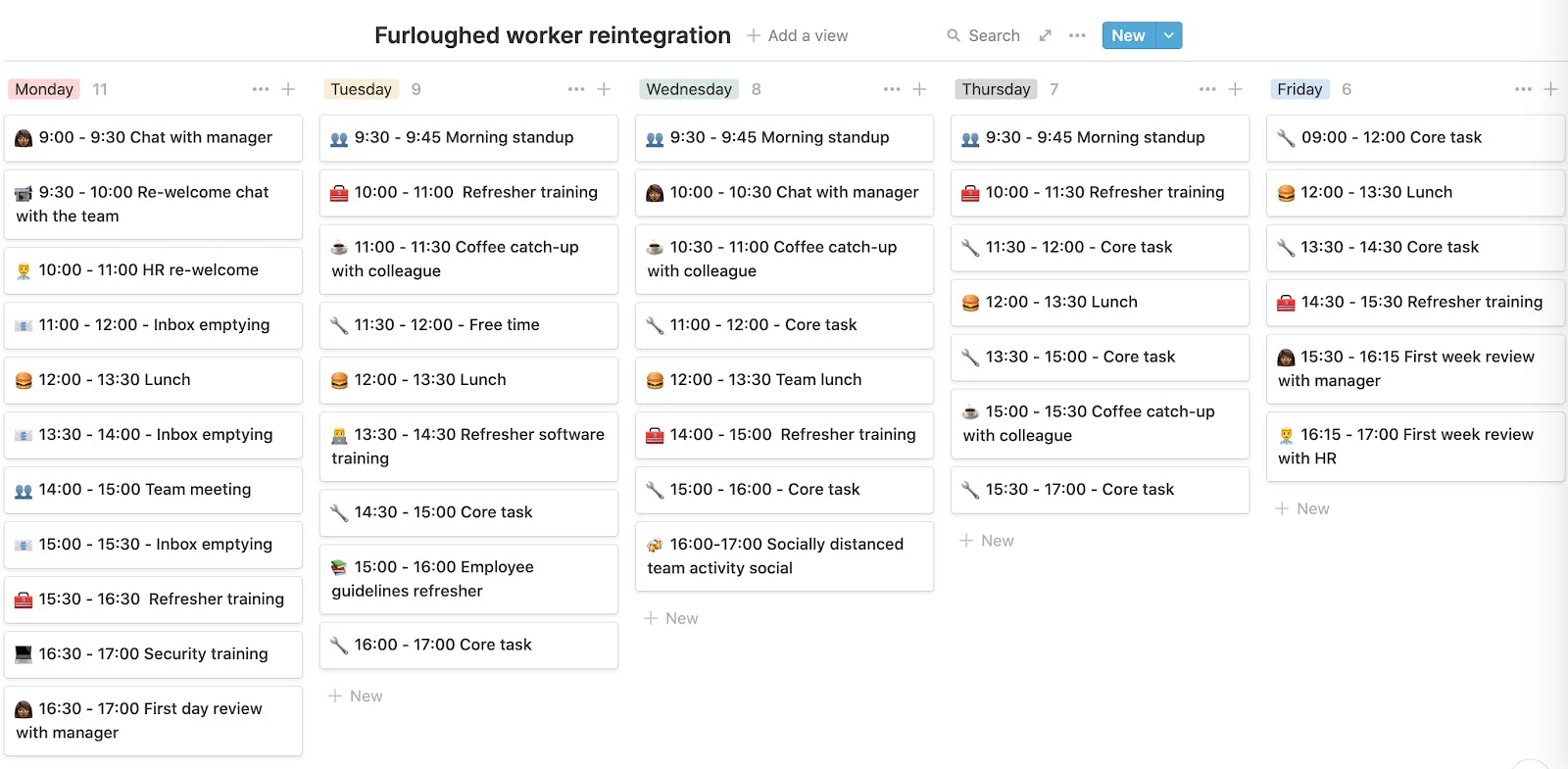Doesn’t March seem like a long time ago now?
It’s so long ago that back then the word “furlough” had barely entered our vocabulary. Six months on, it’s impossible to imagine a world where furlough doesn’t exist.
During this unprecedented time, almost 10 million people have been furloughed under the Coronavirus Job Retention Scheme at an estimated cost of £50 billion.
But as the Scheme enters its final few weeks and begins to wind down, companies are gradually starting to bring furloughed employees back to work.
For these returning employees, coming back to work after such a long period away is bound to be a little daunting.
As an employer, you must know which support structures need to be implemented to ensure that the reintegration of furloughed employees goes as smoothly as possible.
Deciding where to work
The first thing to consider when reintegrating furloughed employees is where they are going to be based.
Over the last half-year, remote work has become common practice and, in a lot of cases, has proven to be remarkably successful.
In fact, it has been so successful that according to a survey run by Hubble HQ, a leading online platform for flexible office space, almost 70% of respondents said that they would like to work at home between 1-4 days a week in the future.
However, for those returning from a long time away from work, introducing the unfamiliar concept of remote work straight away may not necessarily be the best thing to do. That, of course, means bringing people back into an office which, as we all know by now, is much easier said than done.
So, if part of the reintegration process requires employees to return to the office, as an employer, you have a duty of care to ensure that the office is safe for them to do so.
Thankfully, PayFit can help here. We’ve created a document outlining all of the things you need to consider when bringing workers back into the office.
A new induction
Imagine that the reintegration of furloughed employees is a bit like welcoming a new starter to your company.
You wouldn’t expect a new starter to arrive on their first day and just be able to crack on with the job.
In many ways, managing employee returns is much the same.
While it is more than likely that the majority of those returning won’t have completely forgotten their roles and duties during their prolonged absence, it is almost inevitable that they will be a little rusty to begin with and will require short refresher training.
To help manage the process better, there are several things that you could look to do to get your employees up and running quickly.
First, you may wish to consider building a reintegration calendar.
This calendar can act as a sound base for any new returner and can help make sure that they feel settled, relaxed and in control of their tasks on their first week back to work.

Furlough reintegration calendar.
You should also make sure that all returning employees have access to all of the equipment required to perform their roles.
For example, if your employees are going to be working from home and their computer is at the office, make sure that they can collect it safely, or get it delivered out to them.
You should also check with the relevant people within your company to make sure whether access to any tools or databases has been revoked during their time away. If so, it’s crucial that this is set up for their return. There would be nothing worse than returning after so long away and then not being able to do the job because of basic IT or systems issues.
Another thing worth considering is whether or not systems or processes have changed throughout the last few months.
Six months is a long time in a job and, particularly given the current situation, you may have decided to change software providers to save money. In this case, returning employees must be appropriately trained on any changes and given the time to familiarise themselves with the new protocols.
Finally, the most challenging part of managing the reintegration of furloughed employees is likely to be ensuring that everyone is comfortable with the situation.
As a leader, you have to be understanding and sympathetic towards your employees who will all likely react in different ways when returning.
Some may be anxious about their return, particularly if they’ve grown accustomed to their new routine.
Others may feel vulnerable as they may perceive the fact that they were furloughed to mean that their job is expendable and their employment is not secure.
More extroverted employees could well feel excited about coming back and will likely be looking forward to the challenge.
It will be your job to manage the expectations of each returning employee to ensure that they feel at ease, relaxed and able to do their job after such a long time away.
Post-furlough briefing
Work in a post-coronavirus world is very, very different from the world of work employees left behind back in March. The events of the last six months have impacted hundreds of thousands of businesses in very different ways, and it is likely that one way or another your business has also been affected.
So, when an employee returns from furlough, it is vital that they are brought up to speed about what has happened during their time out of work.
You may wish to arrange a seminar for all returning employees to explain what has happened and changed during their time away, as well as to address the current and future challenges that the business will face.
This could also be an opportunity to explain what the company’s objectives are in light of the coronavirus crisis and how returning employees may see specific changes within their roles and responsibilities.
Keeping employees informed about the happenings within your business is crucial for maintaining employee engagement, and those returning will feel that they are entitled to know about what’s gone on.
Communication
In a previous article, we discussed how communication and employee engagement has changed throughout the coronavirus pandemic.
When reintegrating employees, there must be regular dialogue between them, their teams and their managers.
These conversations can take place as informal check-ins, 1-2-1s or even casual coffees or “water cooler chats”.
During these discussions, it is important that expectations, both yours and that of the returning employee, are aligned and in keeping with the current climate.
This may mean that you have to demonstrate a certain level of flexibility. For example, expecting someone to return to pre-coronavirus working habits after such a long time away is probably a little unrealistic.
Therefore, if employees typically work in an office, make the transition more comfortable by offering them the opportunity to work remotely from time to time as they gently ease themselves back in.
The last thing you want is for your employees to return and become burned out in a matter of weeks. To avoid this, you ought to try and keep on top of how they are feeling by speaking to them regularly and assessing how everything’s going – e.g. whether the workload is manageable or if the return to work is a little too overwhelming.
Rebuilding the team
As employees begin to return, you must consider the impact it will have on employees who haven’t been furloughed or who already have returned from furlough.
Warning them in advance and keeping them up to date with any developments will allow them to prepare for the return of their colleagues.
It is also a good idea to consider how the last six months has impacted those that continued to work. Their roles and responsibilities will have almost certainly changed when their colleagues were furloughed, particularly if they had to take on extra work and increased responsibilities.
Consequently, as you begin to reintegrate your returning employees, you mustn’t neglect the other members of your team.
You should take this opportunity to speak with them, establish how they’re getting on, how the last six months have been for them and whether or not they have any concerns about the reintegration of team members.
You may also wish to consider how you can generate team spirit after spending such a long period of time apart.
Organising virtual or even physical events, providing you’ve got the space and numbers to do so safely, could be an excellent way of allowing team members to become reacquainted.
Quizzes are always fun, although if people have been thoroughly quizzed-out during lockdown, there are other alternatives.
Casual drinks could be an excellent way to get people talking, and even something like an online murder mystery could get people having a laugh and relaxing in each other’s company.
From a more professional point of view, morning or daily standups are an excellent way of bringing employees up to speed quickly.
These standups needn’t be long and drawn-out affairs, but they could prove invaluable in helping returning employees understand how the roles of their colleagues have changed over the last few months.
And finally…
The information outlined in this document is a guide and is not science.
As each individual, team and organisation is different, it’s important that you assess the dynamics within your company and come up with your own reintegration process.
This is a situation unlike any we’ve experienced before, which means that the success you have bringing employees back over the next few weeks and months will be dependent on the decisions you make.
As time goes by, things will begin to become clearer, and you will be able to understand the intricacies of your team and the individuals under your management.
However, in the immediate future, you must take the time to speak to your employees, understand their concerns and look to establish processes or support structures that help you to facilitate as smooth a transition as possible.
This post was written by Sophie on the PayFit website here. They are an exhibitor on the HRTech247 Payroll, Time & Attendance floor here.




